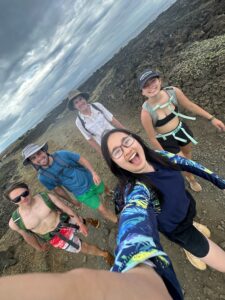By Mac Malambri
I woke up and decided to further explore our part of Hilo. I ran around the area. To the south, there is a park with lots of muddy holes. It has tall trees directly bordering the seashore. Behind the house, there is a narrow road that appears to be surrounded by a jungle. To the north, there is this beach park that is larger than the one across from our house. It is beautiful.
After running, showering, and eating breakfast, I joined the group in departing around 9:30 for the Green Sand Beaches at the south of the island. It was a very long drive that I had the privilege of having aux for. We crossed Kiluaea in Volcanos National Park and decended towards South Point. We stopped for gas and snacks in a little town. It was amazing how expensive regular items are in Hawaii. 12 packs of toilet paper was $35. We took a left off of HI-11 onto this narrow county road that looks like it could be in be in rural Rockbridge county. We broke off the road to the South Point near the windmills. We headed to the green sand beach at Papakolea. Once we parked, we began our hike. It was incredibly dusty. Every step released a cloud of red dust. We hiked alongside the seashore. There were a multitude of rocks, some pebbles, others as big as large flower pots. Sand filled the gaps, making miniature beaches. We hiked through sandy paths around the width of a truck bed that scared the endless grass field like a river scars a delta. After 2.8 miles, we reached a small cove in front of a huge boulder. Within this cove, we find the famed green sand beach.

We descended into the cove and finished our lunches. Professor Knapp gave us a brief introduction to our assignment. We needed to use our handheld lenses to evaluate the minerals in the various layers of rocks in the cove and create a map of the layers. Ultimately, we sought to evaluate the source of the olivine that makes the sand green. The sand where we sat is the greenest, being approximately one third of all three minerals: olivine, calcite, and peroxene. As you approached the water, peroxene increases as the other two decline in content. Likewise as you went above the green sand onto the rocks. Thus, there was rather narrow layer with higher olivine content that was currently on the beach. Since it was lower in the water, the water did not bring in the olivine and it must have been created by weathering basalts made from lava flows. Thus, as the beach continues to be weathered and less olivine is available, the beach will decline.
We also swam a little bit in the cove. The waves were so large. Once the waves brought out the water, the water towered over me. Some locals—who lived on the border of bold and insane—kept jumping into the breaking waves. The waves broke in a spot that was dry when the water pulled out. They were literally seconds from death at every jump. After swimming, we returned through the dirt delta to our cars. We also figured out that Van lost her Apple Watch. We drove back and stopped at the gas station we came through before. Unbelievably, they had Van’s watch. Finally, we stopped at Thai restaurant and enjoyed Sherly Temples together.

